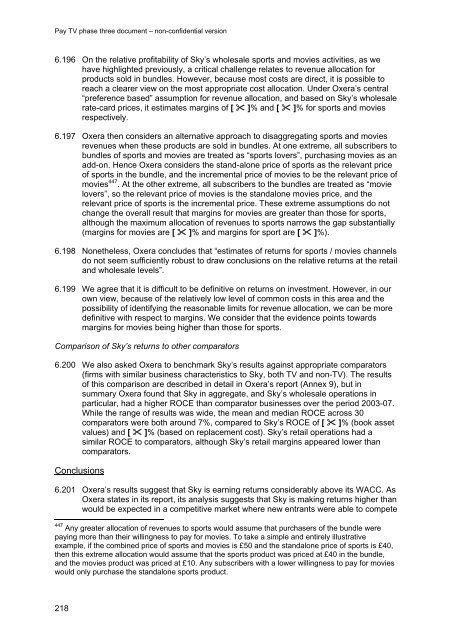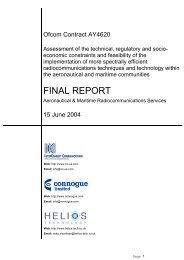Pay TV phase three document - Stakeholders - Ofcom
Pay TV phase three document - Stakeholders - Ofcom
Pay TV phase three document - Stakeholders - Ofcom
You also want an ePaper? Increase the reach of your titles
YUMPU automatically turns print PDFs into web optimized ePapers that Google loves.
<strong>Pay</strong> <strong>TV</strong> <strong>phase</strong> <strong>three</strong> <strong>document</strong> – non-confidential version<br />
6.196 On the relative profitability of Sky’s wholesale sports and movies activities, as we<br />
have highlighted previously, a critical challenge relates to revenue allocation for<br />
products sold in bundles. However, because most costs are direct, it is possible to<br />
reach a clearer view on the most appropriate cost allocation. Under Oxera’s central<br />
“preference based” assumption for revenue allocation, and based on Sky’s wholesale<br />
rate-card prices, it estimates margins of [ � ]% and [ � ]% for sports and movies<br />
respectively.<br />
6.197 Oxera then considers an alternative approach to disaggregating sports and movies<br />
revenues when these products are sold in bundles. At one extreme, all subscribers to<br />
bundles of sports and movies are treated as “sports lovers”, purchasing movies as an<br />
add-on. Hence Oxera considers the stand-alone price of sports as the relevant price<br />
of sports in the bundle, and the incremental price of movies to be the relevant price of<br />
movies 447 . At the other extreme, all subscribers to the bundles are treated as “movie<br />
lovers”, so the relevant price of movies is the standalone movies price, and the<br />
relevant price of sports is the incremental price. These extreme assumptions do not<br />
change the overall result that margins for movies are greater than those for sports,<br />
although the maximum allocation of revenues to sports narrows the gap substantially<br />
(margins for movies are [ � ]% and margins for sport are [ � ]%).<br />
6.198 Nonetheless, Oxera concludes that “estimates of returns for sports / movies channels<br />
do not seem sufficiently robust to draw conclusions on the relative returns at the retail<br />
and wholesale levels”.<br />
6.199 We agree that it is difficult to be definitive on returns on investment. However, in our<br />
own view, because of the relatively low level of common costs in this area and the<br />
possibility of identifying the reasonable limits for revenue allocation, we can be more<br />
definitive with respect to margins. We consider that the evidence points towards<br />
margins for movies being higher than those for sports.<br />
Comparison of Sky’s returns to other comparators<br />
6.200 We also asked Oxera to benchmark Sky’s results against appropriate comparators<br />
(firms with similar business characteristics to Sky, both <strong>TV</strong> and non-<strong>TV</strong>). The results<br />
of this comparison are described in detail in Oxera’s report (Annex 9), but in<br />
summary Oxera found that Sky in aggregate, and Sky’s wholesale operations in<br />
particular, had a higher ROCE than comparator businesses over the period 2003-07.<br />
While the range of results was wide, the mean and median ROCE across 30<br />
comparators were both around 7%, compared to Sky’s ROCE of [ � ]% (book asset<br />
values) and [ � ]% (based on replacement cost). Sky’s retail operations had a<br />
similar ROCE to comparators, although Sky’s retail margins appeared lower than<br />
comparators.<br />
Conclusions<br />
6.201 Oxera’s results suggest that Sky is earning returns considerably above its WACC. As<br />
Oxera states in its report, its analysis suggests that Sky is making returns higher than<br />
would be expected in a competitive market where new entrants were able to compete<br />
447 Any greater allocation of revenues to sports would assume that purchasers of the bundle were<br />
paying more than their willingness to pay for movies. To take a simple and entirely illustrative<br />
example, if the combined price of sports and movies is £50 and the standalone price of sports is £40,<br />
then this extreme allocation would assume that the sports product was priced at £40 in the bundle,<br />
and the movies product was priced at £10. Any subscribers with a lower willingness to pay for movies<br />
would only purchase the standalone sports product.<br />
218
















